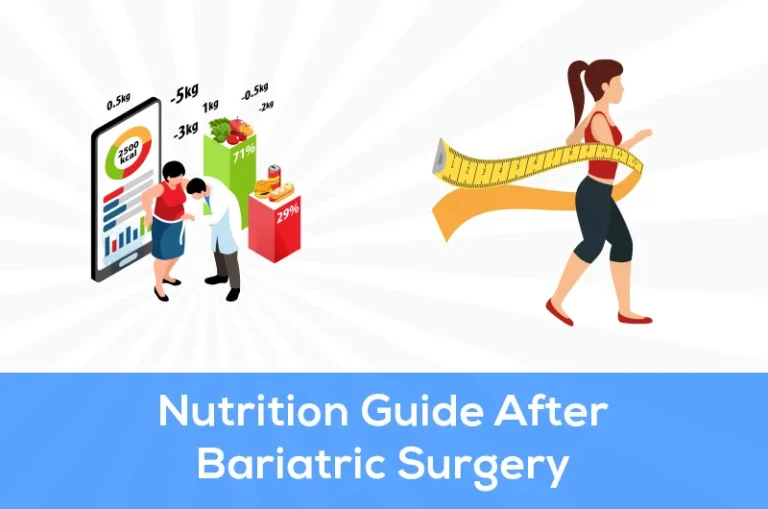After weight loss surgery, it’s important to follow specific nutrition guidelines for successful weight loss and good health. We have designed this guide to help patients adjust to their new stomach size and promote proper recovery. In the diet, it is of great importance to prefer foods that are low in calories but rich in protein and high in nutrients. These foods include lean meat, fish, eggs, dairy products, fruit, vegetables and whole grains.
Bariatric Surgery Diet
It is very important to prioritise protein intake after bariatric surgery to support muscle growth and repair. Protein-rich foods such as lean meat, fish, eggs and dairy products can help patients meet their daily protein needs. It is also important to stay hydrated by drinking plenty of water throughout the day.
In addition to protein, patients should focus on including a variety of fruit and vegetables in their diet to ensure they are getting essential vitamins and minerals. Whole grains can provide fibre to aid digestion and support feelings of satiety. Detailed bariatric surgery diet is described below.
Post Bariatric Surgery Diet
The diet after bariatric surgery typically consists of several phases, starting with a liquid diet and progressing gradually to soft foods and eventually to solid foods. To ensure a smooth recovery and successful weight loss, it is important for patients to follow the guidelines provided by their healthcare team.
Diet and Nutrition After Bariatric Surgery
Following bariatric surgery, embarking on a new dietary and nutritional regimen is essential for maximizing weight loss, ensuring the healing process proceeds smoothly, and laying the foundation for a healthier lifestyle that will support long-term success.
2 week diet after Bariatric Surgery
Week 1: Clear Liquid Diet
The goal during the first week is to stay hydrated and avoid dehydration while ensuring the stomach is not strained with solid foods.
- Daily Fluid Intake: Aim for 64 ounces of fluid per day, sipped slowly throughout the day, not consumed all at once.
- Foods to Include:Clear broths (chicken, beef, vegetable)
- Sugar-free, non-carbonated clear fluids (water, herbal teas)
- Sugar-free gelatin
- Sugar-free popsicles
- Avoid: Any solid foods, carbonated beverages, caffeine, and sugary drinks.
Transitioning to Week 2: Full Liquid Diet
As your tolerance for clear liquids improves, you can gradually introduce full liquids to provide more calories and protein necessary for healing.
- Daily Goals: Continue focusing on hydration and start incorporating high-protein liquids to support tissue repair and muscle maintenance.
- Foods to Include:Protein shakes (low sugar, high protein)
- Low-fat, sugar-free yogurt (blended without chunks)
- Thin cream soups (strained to remove solids)
- Sugar-free pudding and custard
- Blended oatmeal and cream of wheat, thinned with milk or water
- Key Points: Ensure all foods are smooth with no solid pieces to prevent discomfort and complications. Protein intake is crucial, so aim for protein shakes or supplements recommended by your healthcare provider.
Nutrition and Supplement Guidelines
- Protein: Aim for a minimum protein intake as advised by your healthcare provider, typically between 60-80 grams per day, to support wound healing and muscle preservation.
- Vitamins and Minerals: Begin taking chewable or liquid vitamin and mineral supplements as recommended by your healthcare team to prevent deficiencies.
- Hydration: Continue to prioritize hydration. Drink fluids slowly, between meals, to prevent nausea and to ensure adequate hydration without overfilling your stomach.
General Advice
- Listen to Your Body: Pay attention to your body’s hunger and fullness cues to avoid overeating and discomfort.
- Eating Habits: Eat and drink slowly, taking small sips and bites, to improve digestion and absorption of nutrients.
- Follow-Up: Keep regular appointments with your healthcare provider for monitoring and adjustments to your diet plan as needed.
1 month diet after Bariatric Surgery
Week 1: Clear Liquid Diet
- Objective: Maintain hydration and allow the stomach to heal.
- Include: Water, broth, sugar-free gelatin, and sugar-free non-carbonated beverages.
- Avoid: Caffeine, carbonation, and any solid or semi-solid foods.
Week 2: Full Liquid Diet
- Objective: Introduce proteins and calories needed for healing while keeping the diet gentle on the stomach.
- Include: Protein shakes, thin soups, sugar-free pudding, and yogurt without chunks.
- Key Point: Focus on high-quality protein sources to support tissue repair.
Week 3: Pureed Foods
- Objective: Start to incorporate more solid nutrition in a form that is easy to digest.
- Include: Pureed fruits and vegetables, pureed lean meats, cottage cheese, and scrambled eggs. Ensure everything is smooth, with no chunks.
- Avoid: Foods that are difficult to puree thoroughly, such as fibrous vegetables or tough meats.
Week 4: Soft Foods
- Objective: Transition to foods that are more solid yet still soft, preparing for a regular diet.
- Include: Soft fruits and vegetables, tender meats like fish or chicken, soft-cooked eggs, and soft cereals.
- Guidelines: Chew food thoroughly to a pureed consistency before swallowing and continue to avoid tough, crunchy, or very fibrous foods.
Throughout the Month:
- Hydration: Continue to prioritize fluid intake, aiming for at least 64 ounces of water per day. Drink fluids between meals, not with meals, to prevent overfilling your stomach.
- Protein: Aim to consume protein-rich foods or supplements to meet your daily protein goal, usually between 60-80 grams, as advised by your healthcare provider.
- Vitamins and Minerals: Supplement your diet with chewable or liquid vitamins and minerals as recommended to prevent nutritional deficiencies.
- Meal Frequency: Eat small, frequent meals or snacks (about 4-6 times a day) to avoid overwhelming your smaller stomach capacity.
Important Considerations:
- Monitor Tolerance: Pay attention to how your body responds to different foods and textures. If a particular food causes discomfort, nausea, or vomiting, avoid it for now and try reintroducing it later.
- Eating Habits: Eat slowly and chew your food thoroughly to aid digestion and absorption. This will also help prevent dumping syndrome and other gastrointestinal discomforts.
- Follow-Up Care: Keep all scheduled follow-up appointments with your bariatric team to adjust your diet as needed and address any concerns.
3 month diet after Bariatric Surgery
Navigating through the first three months after bariatric surgery is pivotal for setting the foundation of your bariatric diet and ensuring long-term success in your weight loss journey. This period is not just about healing but also about adapting to a new way of eating and living that prioritizes bariatric nutrition. Here’s a general guide to a three-month diet after bariatric surgery, incorporating the key terms you’ve requested.
Month 1: Liquids to Pureed Foods
- Objective: The initial focus is on healing and hydration while preventing any strain on the surgical site.
- Weeks 1-2 (Liquids): Start with clear liquids and gradually introduce full liquids. Hydration is crucial, aiming for at least 64 ounces of fluid daily but consumed 30 minutes before or after meals to avoid overfilling your stomach.
- Weeks 3-4 (Pureed Foods): Transition to pureed foods that are high in protein but low in fat and sugar. Incorporate protein powders into purees to meet protein requirements essential for healing and to support muscle mass, which can help accelerate weight loss.
Month 2: Soft Foods
- Objective: Gradually introduce soft foods that are easier to digest. The focus continues to be on protein-rich foods to support ongoing weight loss.
- Diet: Your meals should include soft-cooked eggs, soft fruits and vegetables, and finely ground lean meats. Protein powders can still play a valuable role in ensuring you meet your daily protein intake goals.
- Nutrition: It’s vital to continue focusing on bariatric nutrition, which means meals high in protein, low in simple carbohydrates, and rich in vitamins and minerals. Eating small, frequent meals and continuing to drink fluids 30 minutes before or after eating is crucial.
Month 3: Transitioning to Solid Foods
- Objective: By the third month after surgery, you’ll begin transitioning to more regular, solid foods. This phase is about learning to maintain a balanced bariatric diet that you’ll adhere to long-term.
- Diet: Introduce a wider variety of solid foods, including lean meats, fruits, and vegetables. Continue to ensure your diet is high in protein to facilitate ongoing weight loss and muscle maintenance. Protein powders can still supplement your diet, especially on days when it’s challenging to meet protein needs through food alone.
- Lifestyle: This month is an excellent time to establish regular physical activity into your routine, starting with gentle exercises and gradually increasing intensity as approved by your healthcare provider. Regular physical activity, combined with your bariatric diet, will support your goals to lose weight and maintain muscle mass.
Throughout the 3 Months:
- Protein Intake: Aim to consume between 60-80 grams of protein daily, using protein powders as a supplement when necessary.
- Hydration: Drink at least 64 ounces of fluids daily, keeping the 30 minutes rule in mind to prevent dehydration and facilitate digestion.
- Nutritional Supplements: Follow your healthcare provider’s recommendations for vitamin and mineral supplements to avoid nutritional deficiencies.
- Meal Planning: Eat small, frequent meals—about 4-6 times a day—to adapt to your new stomach capacity and support weight loss.







